North Vietnam, Cold Wood Prints II, January 30th, 1972, Michel Nr. 683-688; Six stamps with the nominals of 12 xu (four stamps), 40 xu and 50 xu were issued with perforation 11.0 and imperforate. A 30 xu nominal was prepared and printed but was later overprinted “Huy Bo” (=Not valid) and is now considered an un-issued trial proof. The four 12 xu stamps were printed in pairs within a single sheet, two 12 xu stamps per sheet.
Here is a mint strip of four that shows how the first perforated 12 xu values were arranged in the sheet:
Here is the same mint strip of the 12 xu value but this time imperforate:
Here are both imperforate values but this time cancelled to order:
Each sheet contained five rows. In the second and fourth row of each sheet there are small printer markings in-between the stamps. Here is a mint corner block that shows the printer markings in the bottom row/center stamps:
Details scan of the printer markings:
There is also a re-occuring plate error on one of the 12 xu values (Michel 685) that looks like a rock under the feet of right person. Here is a detail scan of that area.
This is the exact part of the 12 xu sheet but this time imperforate that shows the same printer markings and plate error.
Small production flaws did occur. Below is a significant passer shift which shows the orange color shifted down:
The other two 12 xu stamps were also produced together in a single sheet. Here the attachment is not side by side but upside down. Here is a mint strip of the perforated version of these stamps.
and this is the imperforate version of the same stamps:
Here are the two imperforate values but this time cancelled to order:
Here is the perforated 30 xu stamp that was not issued and instead overprinted “Huy Bo”
Here is the imperforate version of the 30 xu stamp. It shows it attached to a 12 xu stamp which also explains how the withdrawn stamp got to market. It was initially printed together in sheets with a 12 xu value and when the 30 xu value was withdrawn, only the 30 xu stamps got the “Huy Bo” overprint. In order to save paper the so overprinted sheets were delivered to post offices with the intent that the 30 xu stamp would not be sold and simply destroyed. However that clearly did not happen in all cases as plenty of 30 xu stamps have come to market. The overprinted 30 xu stamp is not particularly rare. 
Here are the imperforate 40 and 50xu stamps:
The same pair but this time imperforate and cancelled:
Rare Single franking of one of the 12xu values on a letter sent from Hanoi to East Germany in June of 1973.
Very rare large envelope mailed registered and via express mail to Klewitz in July of 1972 Apart from a strip of the first 12 xu stamps it also carries imperforate stamps of the artist and writer as well as the fish stamp set. Imperforate stamps on postally used cover are very rare. The overall postage amounted to 2.02 Dong which appears to be in line with the postal tariff for such a large envelope.
Very rare letter mailed registered and per express mail to Klewitz featuring the imperforate version of the first 12 xu stamps. Imperforate stamps on postally used cover are very rare. The overall franking of the letter amounted to 1.98 Dong which may have been a bit much as a standard 20 gram registered express mail letter to West Germany only cost 1.60 Dong.
Another very rare registered express mail letter sent to Klewitz in July of 1972. The letter features the imperforate other 12 xu stamps. Imperforate stamps on postally used cover are very rare. The overall postage here amounted to 1.80 Dong which may have been a bit above the required tariff of 1.60 Dong.
Rare express mail letter sent to Klewitz in July of 1972 featuring the perforated 40 and 50 xu stamps of the set. It also bears an imperforate 12 xu stamp of the poisonous snake set. Imperforate stamps on postally used cover are very rare. The overall postage amounted to 1.92 Dong which may have been above the required tariff of 1.60 Dong.
Very rare letter mailed registered and via express mail to Klewitz in July of 1972. It features the imperforate 40 xu stamps plus an imperforate 50 xu stamp of the artist and writer set. Imperforate stamps on postally used cover are very rare. The overall postage of 2.02 Dong may have been in excess of the required tariff for a standard 20 gram registered express mail letter to West Germany.
Very rare registered express mail cover mailed to Klewitz in July of 1972. It carries the im-perforated 50 xu stamps plus im-perforated stamps of the artist and writer set. Imperforate stamps on postally used cover are very rare. The overall postage on the letter amounted to 1.84 Dong which may have been a bit above the required tariff od 1.60 Dong. 

Rare express mail letter mailed to Klewitz in July of 1972. The letter bears a perforated strip of the other 12 xu stamps. The overall postage amounted to 2.04 Ding which may have been above the required tariff of 1.60 Dong. Fulda arrival cancel on the reverse.
Very rare registered express mail letter sent to Klewitz in February of 1973. The letter carried the entire set plus some im-perforated stamps from the color wood print and bamboo set. Imperforate stamps on postally used covers are very rare. The overall postage of the letter amounted to 2.58 Dong which appears to be in excess of the required tariff. A standard 20 gram registered express mail letter to West Germany only cost 1.60 Dong.
Mixed franking of three 12xu stamps (including the 12xu Wood Cuts stamp) for an overall postage of 36xu on a letter sent to Hong Kong in August of 1975. The postage of the letter was apparently not sufficient so was assessed with a post due handstamp on front. It is unclear if the postage due was ever collected.
Very rare letter sen to Klewitz in March of 1976. It carries the im-perforated souvenir sheet plus a range of imperforate other NVN stamps. Souvenir sheets and imperforate stamps postally used cover are very rare. The overall postage of the letter amounted to 3.58 Dong which appears to be in excess of the required tariff (1.50 Dong for a standard 20 gram express mail letter).
There are some tonality issues on the 40 xu and 50 xu stamps. There appear to be two printings; one darker in color (left stamps) and one lighter (right stamps) 

This tonality also shows up in the details. Take a look at the frog. The first darker version shows much more muted white dots than the second lighter version.
Of course, the 30 xu stamp was not valid for postage. After all it was clearly market as “not valid”. That did not prevent people from trying to use it anyway. Below is an intra-city letter mailed on November 11th, 1982 from Nguyen Trai to Ho Chi Minh City, City District 5 (Quan 5). While the letter clearly was philatelically inspired it actually did travel through the mail as indicated by the arrival cancel on the reverse two days later. This may be a case where the postal clerk was made to “look-away” for a small gift. Nevertheless even subsequent postal clerks never applied a postage due charge on the letter.
Of course, Klewitz, who was always crafty in trying to create rarities also used the over-printed 30 xu stamps for postage on a letter to himself. Below is a letter from January 1984. The postal tariff for a standard 20 gram letter to Europe was 1 Dong as of January 1st, 1975. The international registration fee remained at 60 xu. There was also a 40 xu surcharge for air mail that applied to each 5 grams of weight. Given that the franking of the overall letter (excluding the invalid 30 xu stamps) was supplemented with a red free frank at the post office of 63 xu the total franking amounted to 2.13 Dong indicates that it was most likely 5 grams of weight.
Registration Nr. 101990




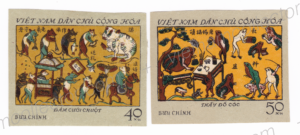
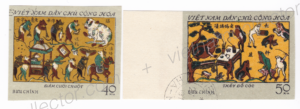










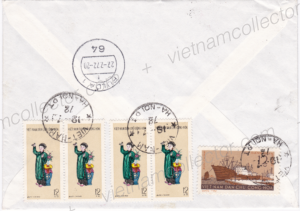
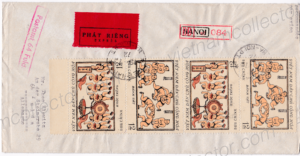




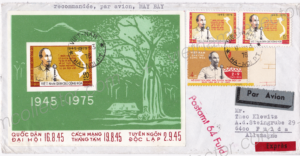












Comments are closed.